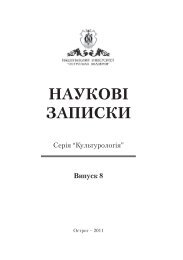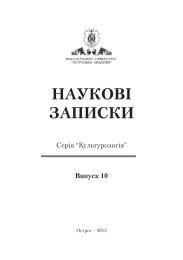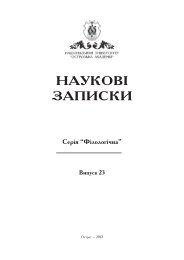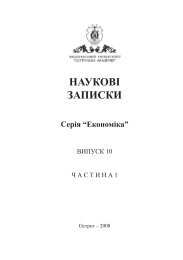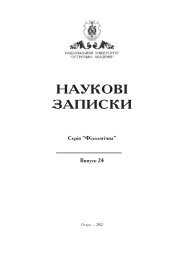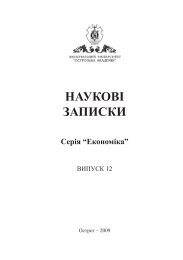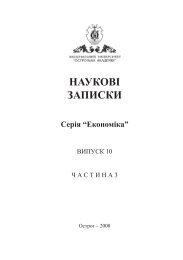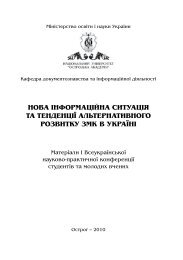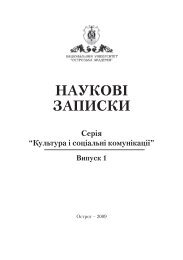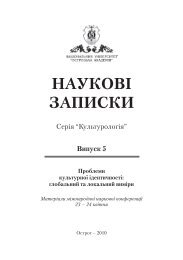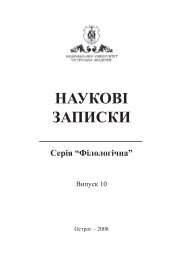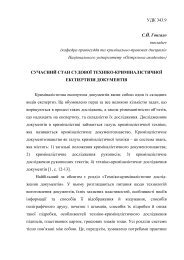ÐÐУÐÐÐÐ ÐÐÐÐСÐÐ - ÐÑÑÑозÑка академÑÑ
ÐÐУÐÐÐÐ ÐÐÐÐСÐÐ - ÐÑÑÑозÑка академÑÑ
ÐÐУÐÐÐÐ ÐÐÐÐСÐÐ - ÐÑÑÑозÑка академÑÑ
You also want an ePaper? Increase the reach of your titles
YUMPU automatically turns print PDFs into web optimized ePapers that Google loves.
4 Наукові записки. Серія “Філологічна”<br />
The drawback of the monitoring surveys over 10-15 years is that they neither provide answers to the question of the<br />
language choice over a longer period of time (including several decades in the history of the Ukrainian SSR) on the one<br />
hand, nor reveal the dynamics of the language choice be it in the family or in the public sphere, on the other hand.<br />
The generation method provides a more detailed analysis of the language choice dynamics. The All-Ukrainian May<br />
2007 survey results analysis of the language choice, considering the present-day generations, reveal, that compared to<br />
their parents, the number of people speaking only Ukrainian in their families decreased by 5. 2%, and the number of<br />
people speaking mostly Ukrainian in their families decreased by 4. 9%. At the same time, across generations, there can<br />
be observed that the number of people speaking a mixed Ukrainian-Russian language increased by 2. 4%, the number of<br />
those speaking only Russian – by 1. 5%, and the number of those speaking mostly Russian by 4. 6% [2, p. 57].<br />
Considering language changes from the previous to the present-day generations in the regional dimension [2, p. 56],<br />
it is easy to observe that the number of families speaking only Ukrainian has mostly reduced in the South and South East<br />
(by 7%), in Central Ukraine and in North-East (by 6. 2%), but not in the extreme, from the language choice point of view,<br />
regions (Western Ukraine, on the one hand, and Donbas area and the Crimea, on the other hand). These regions also<br />
registered the highest growth of the number of people speaking mostly Russian (by 6. 2% in the South and South East),<br />
in Central Ukraine and North East (by 5. 3%). The number of people speaking only Russian compared with their parents<br />
generation grew only in Donbas area and in the Crimea (by 3. 4%).<br />
However, the generation method does not give a straightforward answer to the question when the language choice shift<br />
from one generation to another took place. This shift could presumably take place either 50 years ago when the presentday<br />
70 year old people were leaving their parents families, or 30 years ago when the present-day 50 year old people were<br />
entering their adulthood, or during the last 15 years in independent Ukraine. That is the why the combination of generation<br />
method with the age-period-cohort analysis acquires special significance. It suggests that the share of families speaking<br />
only Ukrainian in the family reduced both in the older (over 55 years old), in the middle (30-54 years old), and in the<br />
younger (18-29 years old) generations, but the pace of this decrease was the highest in the older generation, i. e. by 8. 6<br />
%, while in the middle generation it was by 4. 3%, and in the young generation it was 2. 2%. Conversely, the growth rate<br />
of mostly Russian speaking families reached its peak in the middle generation (7. 1%), compared to the young generation<br />
(3. 2%) and the older generation (2. 0%).<br />
Thus, it can be asserted that the tendency of the present-day Ukrainian speaking families compared to the previous<br />
two generations (formed in the Soviet Union) to reduce in share persevered though it has slowed down, while the share of<br />
Russian speaking families continues to grow at a lower rate (compare: in the middle generation, only or mostly Ukrainian<br />
was spoken by 37. 4% of people, whereas now – 35. 9%, a mixed Russian/Ukrainian language – 18. 5% and 19. 3%<br />
correspondingly, while only or mostly Russian – 43. 5% and 45. 4% correspondingly).<br />
As to the language people think in their everyday life, the share of young people (18-29 years old) who think in<br />
Ukrainian reduced by 8. 4% compared to middle generation (30-54 years old), whereas the share of young people who<br />
think only or mostly in Russian increased by 4. 9% [2, p. 59].<br />
In the area of public sphere communication the share of young people speaking only Ukrainian decreased by 5. 8%<br />
compared to the middle generation, while the share of young people speaking only or mostly Russian increased by 7.<br />
5% compared to the middle generation. It should be noted that the rate of these processes insignificantly slowed down<br />
compared to the previous period [2, p. 57].<br />
In the sphere of professional communication (in the office, in one’s studies, etc.) the share of young people who speak<br />
only Ukrainian reduced by 7. 5% compared to the middle generation, while the share of those speaking mostly Ukrainian<br />
increased by 3. 0%, the share of people speaking mixed Russian/Ukrainian increased by 1. 2%, and the share of mostly or<br />
only Russian speakers increased by 2. 3%.<br />
In this way, the results of the monitoring analysis allow us to conclude that in spite of all the efforts made to increase<br />
the spread of the Ukrainian language in Ukraine after gaining independence, the balance between Ukrainian and Russian<br />
speakers has not changed, instead the number of bilinguals has significantly decreased triggering a sharper differentiation<br />
between Ukrainian and Russian speakers.<br />
A combination of the generation method with the age-period-cohort analysis helps us to conclude, that referring to<br />
the language of thinking, public sphere and professional communication in present-day Ukraine, the share of young<br />
Ukrainian speakers decreased compared to the middle and older generations, while the share of young Russian speakers<br />
increased. In fact, currently, in Ukraine, the share of young people (aged 18-29) who think only in Russian exceed the<br />
share of young people who think only in Ukrainian by 18%. The number of young people speaking only Russian in public<br />
sphere exceeds the number of young people who speak only Ukrainian by 17. 6%. In their professional communication<br />
young Russian speakers exceed the Ukrainian youngsters by 13. 6%. In terms of possible further research, a promising<br />
direction could be the study of efficiency and effects of language policies conducted in Ukraine over the last decades.<br />
Literature:<br />
1 Вишняк О. І. Соціокультурна динаміка політичних регіонів України. Соціологічний моніторинг: 1994-2006.<br />
– К. : Інститут соціології НАН України, 2006. – 202 с.<br />
2. Вишняк О. І. Мовна ситуація та статус мов в Україні: динаміка проблеми, перспективи (соціологічний аналіз).<br />
– К. : Інститут соціології НАН України, 2009. – 176 с.<br />
3. Головаха Є. І., Паніна Н. В. Зміни мовної ситуації в Україні // Українське суспільство: моніторинг – 2000. – 287 с.<br />
4. Дністрянський М. С. Етнополітична географія України: проблеми теорії, методології, практики. – Львів :<br />
Видавничий Центр ЛНУ ім. Івана Франка, 2006. – 490 с.<br />
5. Українське суспільство 1992-2006. Соціологічний моніторинг / За ред. В. Ворони, М. Шульги. – К. : Інститут<br />
соціології НАН України, 2007. – 578 c.



